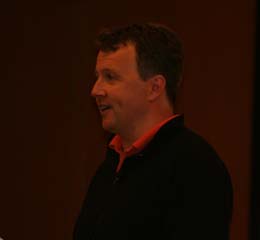This is part of my set of notes from the Startup School 2006 sessions at Stanford.
 Caterina Fake is part of the phenomenal team behind Flickr, the popular photo-sharing web site now owned by Yahoo. In this session, she sat down with Jessica Livingston to answer questions posed by attendees.
Caterina Fake is part of the phenomenal team behind Flickr, the popular photo-sharing web site now owned by Yahoo. In this session, she sat down with Jessica Livingston to answer questions posed by attendees.
If you were doing Flickr again, what would you do differently? What did you get wrong that you would change if you were doing it again?
- Everyone says hire slow, fire fast. They thought they knew that, but they did end up with their backs against a wall with one particular person, made the mistake of hiring too fast and firing too slow. The difference is that Flickr was created as a result when the backend team got so far behind the frontend development team, so it was kind of a blessing in disguise.
- Other errors – they made a fairly stupid product in the end. The IM client thing was kind of neat. Normally you want to make your mistakes fast. We had this “foo” up fast – learned the hard way by creating many products that they killed very fast. Making mistakes is inevitable however, and crucial to the whole development of Flickr.
What sort of usability testing (if any) did you use in developing Flickr? Did you find it helpful?
- Zero. We did none. Get it out early is the best way to do their usability testing. They originally put out this Flash-based IM chat client with photos product. They interacted daily in conversation with their users, watching what they were doing (which is doubly important, because many people can’t tell you what they want). They had open forums where people could report bugs, make suggestions, report bugs. The Flickr employees were answering 50 times a day in the forums – it was a dialog – they developed the product in concert with the users. They wouldn’t have been able to develop it that quickly if they hadn’t done that. People don’t have a problem telling you that something really sucks.
- For example, they redesigned the main photo page (when they were about 50K users) – within 10 minutes, they realized it was a really bad design. One user went so far as to comment: “I’ve had a really bad childhood, and this redesign has just pushed me over the edge”
Why did Flickr not make the move into video sharing to take on YouTube?
- When they started Flickr, they thought it was going to be all things to all people. Video, MP3, rich text, online collaboration tool. We actually started out with a fairly large morass of features we planned on implementing (and actually did in some cases, and then later removed). At some point we had to boil it down to what it actually did – “this is a photo site” – strip down the product to its essence. At the time the media was images – camera phones and digital cameras were just taking off. A lot of the reason the way Flickr evolved were also heavily involved in blogging – unlike other competitors in the space who viewed photos as a loss leader to funnel people to buy photo prints, photo sharing itself was the product.
- Video – I have nothing to announce on that front, but I don’t preclude the possibility of video in Flickr in the future.
How have things changed for Flickr now that you’ve been acquired?
- Prior to acquisition, they were growing extremely quickly and facing scalability problems. As a result, they needed to either get an infusion of cash, or get acquired. Had many suitors, but were looking for someone who had the right DNA and believed in the product as it was. They had a really close relationship with their users, and it seemed to be the place to be. They were looking for a place hat would preserve the ‘isness” of what Flickr was. Startups have the advantage that they don’t have the baggage of the brand that large companies have – so preserving feel of the company is a risk of a small company going into a big company. Caterina had a similar experience as a child with a friend who loved his hamster so much that he crushed it to death (“I love you so much”) – hence the phrase we have, “Don’t hamster me”
Did Ludicorp hire a PR group to stir up buzz for Flickr, or what it user generated? How did you start getting users?
- We, being small and underfunded, developed the product in such a way that it would be viral. They had no marketing/PR budget whatsoever. We had to come up with features that would get the word out. Having a background in blogging (both she and Stewart), blogging seemed like a good way to spread the word. As a result they created features that were tuned to using blogging to get the word out (badges, “Blog this” button). 80% of people found Flickr through blogs.
- At one point we were about to launch our payment service, and users were clamouring to buy more storage. Created a marketing offer of “invite five users and get extra storage for free” – was extraordinarily successful.
- We also had a number of influential articles written by alpha geek writers in popular newspapers and other publications. They wrote the first three articles that were about Flickr (without even interviewing Flickr). As things started to pick up that there was enough momentum that they received calls from reporters; we talked to everyone that we could. Eventually hired a PR firm to handle all the incoming requests, not generate PR.
- When the Internet came around, there was a culture of generosity that made the Internet interesting. Weinberger: In the real world, strangers are a source of fear; on the Internet, strangers are the source of everything good. When you’re designing a user experience, turning people from facing to the web site to facing each other is a very crucial part of how Flickr was designed. Constantly putting people in contact with each other. We launched the IM photosharing client at O’Reilly Emerging Technology conference – spent 24×7 greeting each person who came in, reviewed their profiles, and introduced them to other people. In online communities, it’s like arriving you at a party where you don’t know anybody; there needs to be a host that invites you in, takes your coat, shows you around. As Paul Graham said earlier, people’s finger is poised over the “back” button when they visit your site. The active hands-on experience was crucial to the success.

